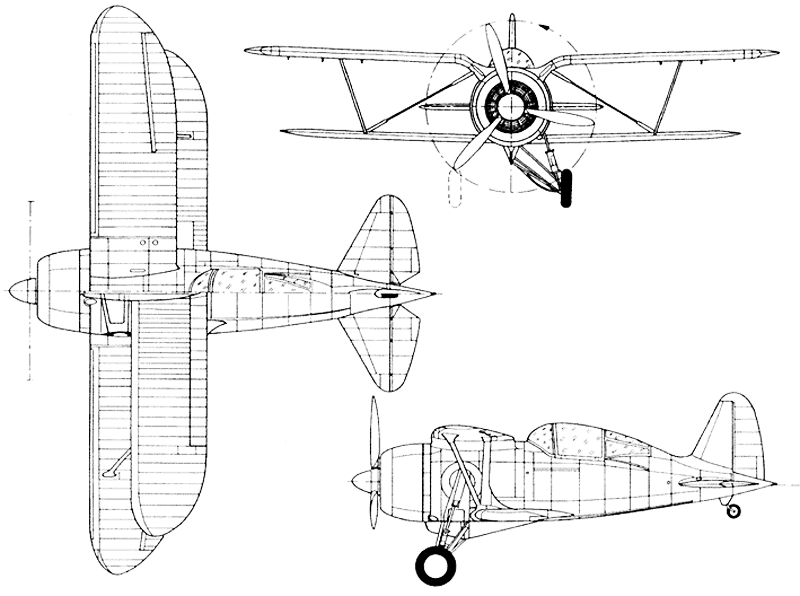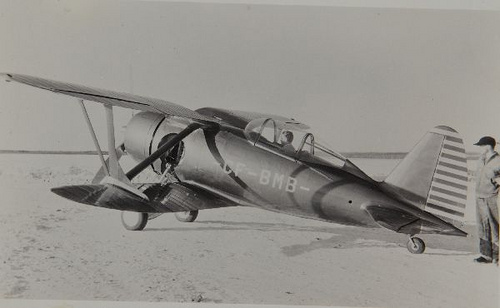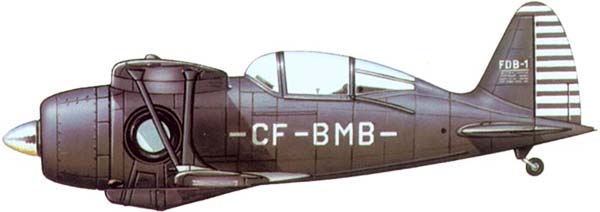Gregor FDB-1The Gregor FDB-1 was a Canadian biplane fighter, designed in 1938 by Michael Gregor and manufactured by Canadian Car and Foundry. Despite being an advanced and innovative design, incorporating all-metal construction with flush riveting, retractable undercarriage and a sleek shape, the FDB-I was overtaken by events and, after being unable to find a buyer, was lost in a fire in 1945.
Design and DevelopmentIn 1938, American and Russian expatriate designer Michael Gregor approached Canadian Car & Foundry, at the time, that country's leading manufacturer of rolling stock, which had limited experience building airplanes, but wanted to enter that field. Instead of building its own designs, Can-Car was producing Curtiss, de Havilland, Consolidated, Bristol and Hawker products under license. In 1936, Grumman and Canadian Car & Foundry or "Can-Car" concluded an agreement for production of 50 revised Grumman SF-1 carrier fighters, with 700 hp. Wright R-1820-78 radial power-plants and known as GE-23s or Grumman Exports 23s, that would be put together in Canada (although some were actually assembled in Spain).
In 1938, there were many aviation observers who doubted the supposed merits of the emerging monoplane over the proven performance of reliable biplanes. Most of the major powers' front line fighter units employed biplanes. The Soviet Union, despite having recently developed the Polikarpov I-16 (the first successful production monoplane fighter with retracting gear), still depended heavily on biplanes. Great Britain's RAF and Nazi Germany's Luftwaffe had likewise embraced the monoplane but, respectively, continued to deploy the Gloster Gladiator and the Heinkel He 51 biplane fighters. In Fascist Italy, the series of Fiat CR.32 in operation and the Fiat CR.42 biplane fighters were entering service while the U.S. Navy operated biplane fighters exclusively.
Similar in size and dimensions to Grumman's F2F Navy fighter and also designed to operate from aircraft carriers as a dual fighter/bomber, Michael Gregor's FDB-1 had an empty weight of 2,880 lb and a gross of 4,100 lb. As in many other gull wing fighters, pilot's view while flying straight and level was excellent, but marginal when landing and extremely poor when looking downward during that critical phase. Hydraulically operated landing gear retracted flush into large wells on either side of fuselage, ahead of the lower wing. Twenty-eight foot span top wing featured nearly full span slats measuring 10 ft (3 m) per side, plus all-metal split flaps of 4 ft (1 m), 3 in per side, positioned between root and ailerons. Bottom wing span of 23 ft (7 m), 10 in also incorporated longer split flaps of 7 ft (2 m), 9 in per side. Like many a Soviet and Polish contemporary that had preceded it, biplanes as well as high-wing monoplanes – the center section of the top wing on Gregor's trim fighter had a gull-wing configuration, attached at right angles to the fuselage for less drag. This was supposed to afford improved visibility too, particularly straight ahead in level flight.
The compact 21 ft (6 m), 8 in fuselage of the Model 10 FDB-I utilized a monocoque shell of circular cross section, covered by flush-riveted, stressed skin. The all-metal wings were fabric covered behind the front spar and metal-framed control surfaces were also fabric covered. An anticipated range of 985 miles (1,585 km) was based on 95 gallons of fuel carried in a pair of semicircular-shaped tanks mounted side-by-side in the fuselage, between the wheel wells. The structure was extremely robust and capable of withstanding stress forces 60 percent above requirements. A pair of fuselage-mounted .50 cal. machine guns, synchronized to fire through the Hamilton Standard's nine ft propeller arc, were part of the design, but armament was never installed. Additionally, two 116 lb bombs were to have been carried, one under each lower wing.
Streamlining on the FDB-1 was accentuated. The engine was snugly faired into a NACA cowling reminiscent of earlier Seversky fighter designs, also heavily influenced by Gregor, who left that company early in 1937. The rearward sliding center section of cockpit's canopy, spacious for such a small airframe, was a unique Gregor innovation. The FDB-1 clean lines partly were accomplished by the attachment and support of wings via substantial faired "V" interlane struts. Flying and landing wires and cables were replaced by a single faired strut running between the root of the top wing rear spar and the foot of the "V" strut where it joins the lower wing at its front spar. A system of tubes moved the control surfaces, except for the rudder, which was partially operated by cables.
Operational HistoryWhen rolled out, the Gregor FDB-1, as it was called, for
Fighter
Dive
Bomber, was not only robust and solid, it also looked exceptionally sleek. Registered CF-BMB, the letters embossed in white over a high gloss metallic dark gray paint job, the dual purpose aircraft's only other markings were ten horizontal white bands on its rudder.
Early in 1938, in a spirit of Commonwealth cooperation, a wooden model of Gregor's new Model 10 fighter was sent to Hawker Aircraft's wind tunnel facility at Kingston upon Thames, England. Manufacture of the prototype began at Thunder Bay, on the north shore of Lake Superior, shortly thereafter. The aircraft, c/n 201, was completed by mid-December 1938, "amid an atmosphere of war jitters, well salted with tales of German spies visiting the factory in disguise."
On its first flight test on 17 December 1938 Can-Car Test pilot George Adye put the FDB-1 through a preliminary flight test program carried out at Can-Car's Bishopfield Airport, Thunder Bay, on Lake Superior. Ayde immediately noted the upper gull wing was a major defect as on takeoff and landing, a pilot's vision was severely limited downward and forward. Ted Smith who tested the FDB-1 in 1941 was more succinct when describing visibility over the gull wing, "blind as hell." While expressing enthusiasm over its maneuverability, Ayde warned that the controls were far too sensitive and the angles of the lowered flaps too great. His assessment was correct; on a subsequent landing, the prototype flipped on its back, although the damage was kept to a minimum due to its rugged construction.
Among the new devices incorporated within the FDB-1 was an anti-spin parachute in its tail cone. The pilot activated the parachute from the cockpit by a three-position switch. The first opened the cone, the second deployed the chute behind the aircraft, and the third released the connecting cable.
Recorded top speed was only 261 mph (420 km/h) at 13,100 ft (3,990 m), with the old P&W R-1535-72 engine of 700 hp, which had powered the Grumman F2F-1. But that aircraft, with a slightly lower empty weight, had only reached a top speed of 230 mph (370 km/h). With the installation of an improved P&W R-1535-SB4-G of 750 hp, top speed was expected to rise to 300 mph (500 km/h). Meanwhile, Gregor had already programmed his fighter to accept the 1200 hp. P&W R-1830 Twin Wasp then being installed in Grumman's new monoplane fighter, the XF4F-3; and with it, he fully anticipated a top speed of 365 mph (587 km/h). Initial rate of climb was an exceptional 3,500 ft (1,070 m). per min, compared to Grumman F2F's 2,050 ft (625 m) per min. with same engine. Service ceiling was estimated at 32,000 ft (9,800 m), 5,000 ft (1,520 m) higher than the F2F's. FDB-1 had a cruise of 205 mph (330 km/h), a low-speed capability of 72 mph (116 km/h) clean and, with flaps and slats open, 58 mph (93 km/h). All these figures were reached without armament, ammunition, armor plate and other military equipment including self-sealing fuel tanks.
Designed, built and tested in less than eight months, the FDB-1 Model 10 was sent to Saint-Hubert Air Base, near Montreal, for preliminary service testing with the Royal Canadian Air Force. After extensive trials, pilot evaluations complained of severe canopy vibration at speed and during strenuous aerobatics, and it was recommended that all testing be restricted until this bothersome defect had been remedied. Unfortunately for Gregor and Can-Car, further tests undertaken by the RCAF showed that his first projections were extremely optimistic and doubted further refinements would make a difference. Nevertheless, the FDB-1 did demonstrate amazing maneuverability; below 15,000 ft (4,600 m), in spite of an adversary's superior speed, no contemporary single-seat, low-wing monoplane could successfully engage Gregor's design which climbed like a "homesick angel," with an initial rate of 3,500 ft (1,070 m) per min, one third better than the new Hurricane and Spitfire. Test pilot Ted Smith thought that the FDB-1 was intended for "mountain" fighting once he sampled its phenomenal climbing ability.
SpecificationsGeneral characteristicsCrew: 1
Length: 21 ft 8 in (6.604 m)
Wingspan: 28 ft (9 m)[7] (8.53 m)
Height: 9 ft 4.5 in (2.86m)
Empty weight: 2,880 lb (1,306 kg)
Loaded weight: 4,100 lb (1,859.7 kg)
Powerplant: 1 × Pratt and WhitneyR-1535-72 9-cylinder radial engine, 700 hp (521.9 kW)
PerformanceMaximum speed: 261 mph at 13100 ft (420 km/h (261 mph) at 4,000 m)
Range: 985 mi (1,585 km)
Service ceiling: 32,000 ft (estimated) (9,906 m)
Rate of climb: 3,500 ft/min at sea level (1,066.8 m m/min at sea level)
Armament2×0.50 mm machine guns
2X 116 lb (kg ) of bombs under wings
Pics:








Hope you guys like the looks of this one as much as I do.

Sincerely,
PvF
 Author
Topic: Gregor FDB-1 (Read 4615 times)
Author
Topic: Gregor FDB-1 (Read 4615 times)


